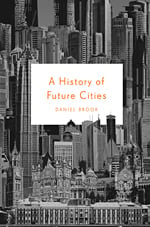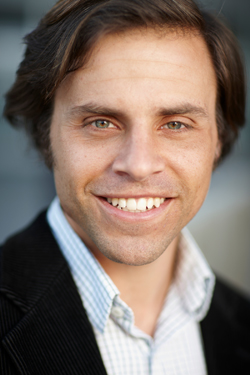A History of Future Cities
Daniel Brook on the lessons of four great Eastern cities that sought to imitate the West
Readers in New York City are invited to join Daniel Brook in launching A History of Future Cities tonight at 7 at the Powerhouse Arena in Brooklyn.
What do Dubai, Mumbai, Shanghai, and St. Petersburg have in common? As Harper’s Magazine contributor Daniel Brook explains in A History of Future Cities, all four of these Eastern metropolises were originally modeled, through colonialism or competition, on the West, but each developed its own unique brand of modernity. Harper’s put six questions to Brook about the future of globalization in our “Asian century.”
1. Let’s start with the book’s title. What do the four cities in your book tell us about the cities of the future? Are they more cosmopolitan or modern than the Western metropolises that they all sought at some point to imitate?
A History of Future Cities profiles precociously modern cities, places that jumbled a cosmopolitan mix of people and ideas with disembodied architectural and cultural fragments of the West, long before this was common. By reading these cities’ raucous histories as “dress rehearsals for the twenty-first century,” I argue, we can get our bearings in the world today.
While these cities all initially hoped to impersonate the West and thereby catch up to it, they were also free of some of the historical constraints of the Western places they copied, which gave them the capacity to leapfrog into the future. St. Petersburg State University, founded by Peter the Great in 1724, physically dwarfed the universities of Western Europe — laid out on newly drained swampland, the main building could stretch for a third of a mile. It also outdid the West sociologically, by admitting women from the start. Western European universities, developing out of church-affiliated institutions, would take much longer to embrace the modern value of coeducation. Similarly, Shanghai in its pre-Communist period was the most open city on earth, with neither passport nor visa required for entry. One of Jazz Age Shanghai’s leading designers was Ladislav Hudec, an architect born in Austria-Hungary who escaped to Shanghai from a Siberian POW camp, married a German-British woman, lived in a Tudor Revival mansion in the French Concession, and grew rich building American-style suburbs (that still stand) for a Shanghai-based real estate developer from California.
2. After reviewing the long history of colonialism in Mumbai, with its funhouse-mirror image of the West transposed on the East, you hope that the city might finally “stop fighting about whether to copy China or America and instead reinvent what it means to be Indian.” Are there moments in Mumbai’s post-Independence history that displayed this potential?
The drive for Indian independence grew out of Mumbai, but the anti-imperialists also loathed the city as the physical embodiment of the Raj. Indian nationalism, especially under Gandhi, with its pastoralist love of pre-urbanized India, was a rejection of Mumbai and all it represented as the greatest metropolis of the British Empire. In the initial independence period, the rural subcontinent asserted itself against the global island city off its coast. Today, with the economic liberalization of recent decades, Mumbai, being India’s financial capital, is booming again, but what has been built thus far — forty-story Greek-temple apartment buildings and $1 billion American-designed personal high-rises — is unworthy of the city that invented Indian modernity.
That said, it took decades of the British airlifting Gothic structures into Mumbai before Indian architects created their own tropical Art Deco vision for the city in the 1920s and 1930s. Right now, only two decades into reglobalization, it’s still too soon for similarly interesting and appropriate styles to take root. But from talking to the younger generation of architects in Mumbai, I’m hopeful that they will.
3. In early twentieth-century Shanghai, home to principally European and American “Shanghailander” businessmen, a “business language” arose out of a mixture of English, Portuguese, and various dialects from India and China. You call this “Esperanto-esque” language a “leap into the modern world even beyond St. Petersburg, whose elite spoke perfect French.” Do you see this inclusive form of multicultural communication as our future?
I wish. Unlike St. Petersburg, which embraced French, and the Mumbai elite, who embraced English, Shanghai operated with a hybrid pidgin language that has left fragments in colloquial English today, including the phrases “chop chop” and “no can do.” I think there’s something deeply just about meeting one another in a cosmopolitan city on a kind of neutral linguistic ground. Shanghainese pidgin died out with the Cultural Revolution, and today the reglobalizing city is opting for a nationally standardized Mandarin as its primary language, with English as its quasi-official second language. Having English proficiency is one of the criteria that determine if a Chinese citizen can legally move from her birthplace to Shanghai. Sadly, I don’t think Shanghainese pidgin is coming back.
4. All of the cities in question, during the modernizing periods that you study, were definitively male, as places to work in industry rather than raise families. You consider what this has meant for the business of prostitution in these “future cities,” but were women otherwise excluded from participating in the modernization process?
This is a fascinating and important question. The cities I profile were to a large extent cities of migrant men seeking their fortunes, and most often in these cities — and in the book — women show up as sex workers. That said, the idea of a men-only rights-based modernity has always been short-lived: it was only two years from Mary Wollstonecraft’s Vindication of the Rights of Men to her Vindication of the Rights of Woman. In Jazz Age Shanghai, there were, yes, more prostitutes per capita of female population than anywhere else on earth, but there was also Shanghai’s answer to the flapper, the Shanghai Girl — a woman with unbound feet who worked outside the home, often as a bilingual secretary, smoking cigarettes, dancing in nightclubs, and dating suitors rather than having an arranged marriage. (To describe their unmarried significant others, the Shanghainese had to create a new word, “daling,” derived from the English word “darling.”) The experience of the Shanghai Girl, liberated inadvertently by a city that was intended to give only white men first-class citizenship, mirrors the experience of the subject peoples of Asia, who imbibed the political value of self-determination in places like colonial Shanghai and Bombay and turned it against their colonizers.
5. You call our time the beginning of an “Asian Century.” What would it mean for modernity to no longer be a euphemism for Westernization?
The book starts in a West-over-East world, with Peter the Great on his incognito 1697 journey to Western Europe, growing despondent over his nation’s comparative backwardness. In the coda to the book (excerpted in Harper’s in January), I try to pivot from there to today’s world, with Asia on the rise: “[I]n America’s burgeoning Chinatowns, high-rise buildings that stack offices atop karaoke parlors atop restaurants atop shopping malls bring the distinctive urbanism of twenty-first-century China to the United States, just as Americans brought their architecture to their Shanghai concession 150 years earlier.” Last weekend, I visited one such project, in Flushing, Queens, to photograph it for an architectural slide presentation. On this visit, I noticed another building, a small corner-retail location with a produce market on the ground floor and a restaurant above. Stacking the two in the contemporary Chinese style allows the structure to feed far more New Yorkers than either operation could alone. More important than this being Chinese urbanism is that it’s good urbanism. It’s a smart use of space for a crowded place like Flushing, where more than a dozen bus routes converge at the terminus of the 7 train. It’s strange that Rem Koolhaas’s Delirious New York, ostensibly the font of dizzying, maximum-city urbanism, had to learn this architectural trick from China. But in a more equal world we can all learn from each other, adopting site-specific best practices that may have initially arisen on the other side of the world rather than forms imposed from above. In this way, we can have a global modernity that is not simply Western modernity gone global. We can build a global future that is neither neocolonial nor placeless.
 6. A History of Future Cities is a significant work of historical journalism. You must have spent a great deal of time immersed in archival research, in long stretches between or without live subjects. When digging for century-old information, how did you know when to stop? What were some of the stories or topics that you were forced to leave out?
6. A History of Future Cities is a significant work of historical journalism. You must have spent a great deal of time immersed in archival research, in long stretches between or without live subjects. When digging for century-old information, how did you know when to stop? What were some of the stories or topics that you were forced to leave out?
I drafted most of the historical portions of the book while on a fellowship at the Library of Congress, where I could dig through their massive collection for quotes and period details. When I feverishly drafted the first chapter from all this material and showed it to my editor, it was running twice as long as it should’ve been. He reminded me that to cover this much ground, the book would have to be “episodic,” which was the right advice. But it also meant cutting out many episodes that were fascinating but just couldn’t fit. For example, both Mumbai and Shanghai had love affairs with Hollywood movies and New Orleans jazz during the 1920s and 1930s. But it became necessary to pair each city with just one cultural form. I chose film in Mumbai because with Bollywood it became more important than jazz there, and I discuss jazz in Shanghai because it was the most important city outside the U.S. for jazz in that era. But that meant I had to cut the amazing story of Teddy Weatherford, an expatriate African-American, New Orleans–trained jazzman who served as bandleader in the Taj Mahal Hotel, as well as the tale of the Shanghai premiere of the 1939 Hollywood blockbuster The Hunchback of Notre Dame, which boasted an honor guard of fifty Chinese hunchbacks lined up outside the theater. It’s a testament to the cosmopolitanism of these cities that they can be so unwieldy for a writer.



